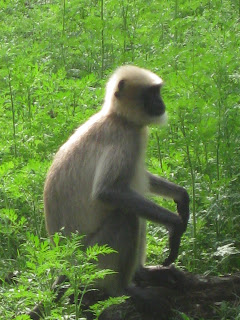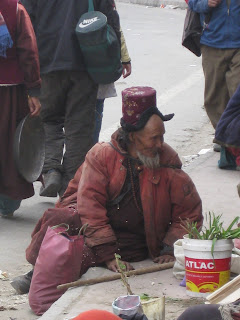
Tuesday, May 11, 2010
Kabini


For our last weekend in India, we rented a bungalow in a resort on the Kabini River, which bisects the Bandipur Tiger Reserve and the Nagarahole National Park. We didn't see any tigers, but we did see a lot of other animals - including many elephants. The resort was fabulous, here's the view from our porch and Bill enjoying the view.-
Tuesday, April 27, 2010
Construction Photo
 They're building a new building on our block. Much of the heavy work (such as carrying concrete) is done by women, who do the work wearing beautiful saris and flip-flops. They live onsite with their families and their dogs - the blue shape to the right behind the people is the roof of a residential tent. In the evenings, they cook over fires at the edge of the street and the babies play in the sand.
They're building a new building on our block. Much of the heavy work (such as carrying concrete) is done by women, who do the work wearing beautiful saris and flip-flops. They live onsite with their families and their dogs - the blue shape to the right behind the people is the roof of a residential tent. In the evenings, they cook over fires at the edge of the street and the babies play in the sand.
Delhi Street Scenes


We weren't terribly fond of Delhi. Old Delhi's streets were interesting, but the city is terrifically crowded, the traffic is overwhelming and it's hot, dusty and dirty. You could feel the grit on your skin from all the dust blowing around and if you were out and about wearing a white shirt, by evening it had literally turned grey. The day we walked around the most it was 106.7 degrees - no wonder after a few hours I longed only for a shower, a book and air conditioning! Bill walked for another 5 hours or so, I'm surprised he didn't get heat stroke.
About Leh - or Why Leh?
Leh is in the Himalayas in very northern India, northwest of Nepal. It's the primary city in Ladakh which is part of the state of Jammu and Kashmir (although there are rumblings about splitting off from J & K). Ladakh is India's most remote and sparsely populated region. The town of Leh is at 3505 meters and has the highest elevation commercial airport in the world - at least according to the guidebooks. Roads into Leh from the south are only open from late June until late October. Ladakh borders both China (Tibet Autonomous Region) and Pakistan, so security is a huge concern and the military has a very significant presence in town. Leh is largely Tibetan and Buddhist - outside town, near Stok, is the Tibetan refugee camp at Choglamsar. Leh and the area around it is unlike anywhere else in India. In April when we were there, spring was just coming to the mountains and while it looks brown in the photographs, green shoots were everywhere. Every day was warmer than the previous day, and we watched the snow recede from the mountains. The air in Leh is thin (we had to rest for the first 36 hours we were there) and there is very little water or electricity. The monsoons don't reach Leh and they get very little snow. Annual rainfall is something on the order of four inches a year. Melting glaciers and snow from the mountains provide most of the water, which is channeled and collected for agriculture and domestic use. Electricity is scheduled only for 6-11 pm daily, in practice it was rarely available before 6:30 at the earliest - which in April in the mountains is after dark. Shops are either dark or powered by generators. Heating and cooking is by propane. With most of the rest of India at or above 100 degrees (April is the hottest month here) the temperature was no small factor in our decision to go to Leh. It really is a beautiful place.
The Oriental Guest House in Leh




This is where we stayed and the view from our room. They were adding a floor to one of the buildings, the wood trim was carved onsite. They were building without the use of electricity, since electricity in Leh is scheduled for a maximum of five hours a day, and usually came on between 6:30 and 7:00 pm. Until evening there is no electricity.
Subscribe to:
Comments (Atom)
Blog Archive
-
▼
2010
(56)
-
►
April
(24)
- Construction Photo
- Miscellaneous Neighborhood Pics
- Monkeys and Pigs
- Delhi Street Scenes
- Scary Electric Lines
- A Tree at the Red Fort in Delhi
- Delhi Shops
- About Leh - or Why Leh?
- The Mountains
- Leh
- The Town of Leh
- Leh Street Scenes
- The Oriental Guest House in Leh
- People from Leh
- On the bus...
- Stok Palace
-
►
April
(24)
About Me
- Barb
- Spending 12 weeks in India, mostly in Bangalore.








































